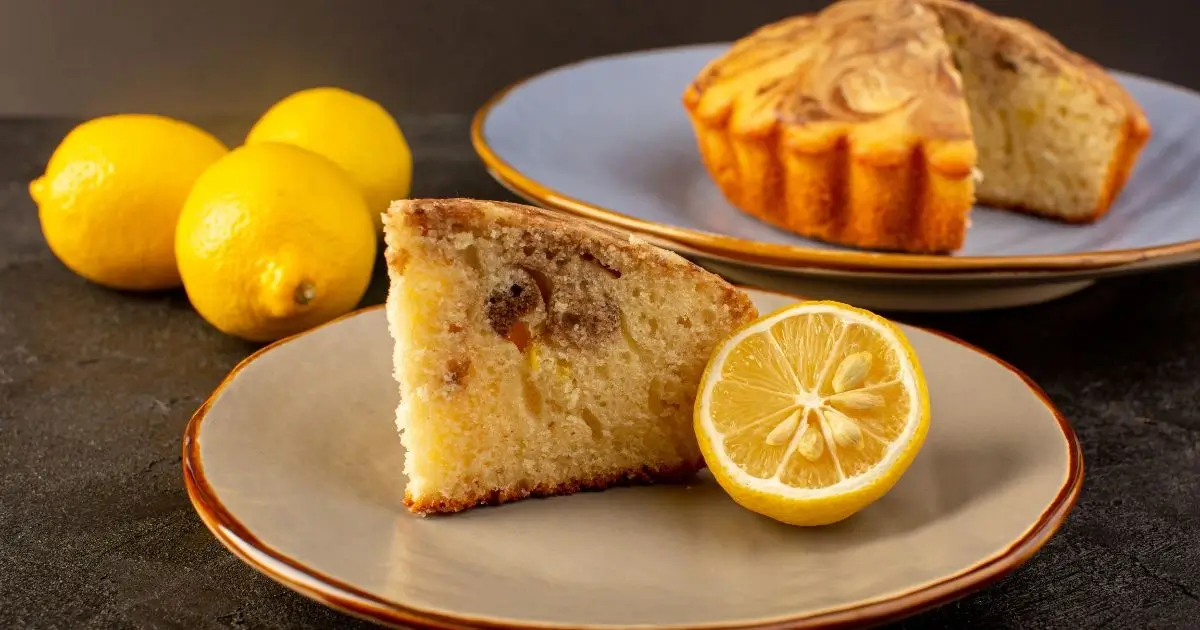Lemon Cream Cheese Pound Cake Recipe
introduction
I didn’t expect much from it, to be honest. Another pound cake recipe, another lemon variation. Been there. But this lemon cream cheese pound cake turned out to be one of those rare bakes that makes you stop, mid-chew, and go: “Wait. Hold on.”
It’s not loud or overdone. No outrageous toppings or trendy spins. Just cream cheese tucked into the batter for richness, lemon that feels bright but not acidic, and a crumb so soft it borders on unfair. It tastes like the kind of dessert someone’s southern grandma would guard with passive-aggressive pride, and I mean that as the highest compliment.
You don’t need to be a baking expert to pull it off. Just enough time, the right ingredients, and a little trust in the process. I’ll walk you through it, step by step.
And if you’re still on the fence? Bake it once. You’ll see.
Table of Contents
Ingredients for Lemon Cream Cheese Pound Cake
Before we dive in, here’s something I’ve learned the hard way: how you prep your ingredients matters just as much as what they are. So while this list might look straightforward, the little details? They make the cake.
For the cake:
- 2 sticks of unsalted butter, softened
(That’s 226g, or one cup. Don’t rush it—let it soften on the counter, not in the microwave.) - One 8-oz block of full-fat cream cheese, room temp
(No low-fat. No whipped tubs. Just the classic brick.) - 3 cups of granulated sugar
(Seems like a lot, and it is. But it’s pound cake—we’re not here for subtle.) - 5 large eggs, at room temperature
(Tip: Forgot to take them out? Warm water bath for 5–7 minutes does the trick.) - 3 cups cake flour
(Not all-purpose. Not self-rising. I use Swan’s Down, but any bleached cake flour will work.) - ½ teaspoon baking powder
(It’s a dense cake, but this gives it a little lift.) - ½ teaspoon salt
(Skimping on salt is a mistake. It matters here.) - ¼ cup whole milk or 2%
(Skim won’t cut it, it’s too thin.) - 1 tablespoon lemon extract
(The real stuff makes a difference. Avoid imitation if you can.) - ¼ cup fresh lemon juice, plus the zest from that lemon
(If your lemon gives less juice, just top it off with a splash of milk—no big deal.)
For the glaze:
- 1 cup powdered sugar
(Try to sift it first unless you like lumps.) - 1½ teaspoons milk
(Add slowlyyou can always add more, but you can’t take it out.) - Pinch of salt
(Surprisingly helpful in cutting through the sweetness.) - Optional: ½ teaspoon lemon extract
(Totally your call. I like it, but it’s not mandatory.)
Is it okay to use all-purpose flour?
Sure, in a pinch. But expect a slightly heavier crumb. If you want to fake cake flour, remove 2 tablespoons of flour per cup and add 2 tablespoons of cornstarch. Then sift it like crazy.
How to Make Lemon Cream Cheese Pound Cake
Let me be clear up front: this cake isn’t hard to make, but it is easy to mess up if you rush. It’s more “take-your-time-and-enjoy-the-process” than “whip-it-up-on-a-weeknight.” Which, honestly, is part of its charm.
Step 1: Get your pan and oven ready
Butter every crease of that bundt or tube pan like it owes you money. Then flour it lightly. Tap out the excess.
Now’s a good time to preheat the oven to 325°F. And yes, that specific temp matters here.
Step 2: Mix your dry stuff
In a bowl, whisk together the flour, baking powder, and salt. Nothing fancy—just enough to distribute things evenly so you don’t get a salty pocket somewhere weird.
Step 3: Cream the butter and cream cheese
Drop the butter and cream cheese into your mixer bowl and beat them until they look like one smooth, fluffy thing. No streaks. If it looks curdled, you’re too cold let it sit and come back to it.
Step 4: Add sugar and beat the heck out of it
Slowly pour in the sugar while mixing, then crank it up and beat for a full 3 minutes. It should look light and a little shiny. This step is non-negotiable, it’s what gives the cake that dreamy texture.
Step 5: Eggs go in, one by one
Crack each egg in, mix until it vanishes, then repeat. If you dump them all in at once, you’ll get streaky batter. No one wants a streaky batter.
Step 6: Lemon-milk mix time
In a small bowl, stir together the milk, lemon juice, lemon zest, and lemon extract. It smells unreal at this point. That’s a good sign.
Step 7: Alternate dry and wet into the batter
This is where people usually overmix. So go slow. Add a third of the flour mix, then half the lemon mix, then repeat, ending on dry. Stir only until it comes together. It’s okay if it’s not perfectly smooth.
Step 8: Spoon into the pan
The batter will be thick. Like, spatula-is-struggling thick. Smooth it down gently and maybe give the pan a little tap on the counter to settle things.
Step 9: Bake
Pop it in the oven and let it go for about 65–75 minutes. Don’t open the door too early. Start checking after an hour with a toothpick—it should come out mostly clean.
Step 10: Cool it, then flip it
Let the cake sit in the pan for 10 minutes. Not 5, not 30—ten. Then turn it out. If you greased your pan right, it should come out clean. If not…well, glaze covers a lot of sins.
Making the Glaze
- Whisk the powdered sugar with a splash of milk and a pinch of salt. Add the milk slowly—it goes from paste to pour in seconds.
- Add lemon extract if you want extra zing.
- For drizzle, keep it loose. For piping, make it thicker. You’ll know when it feels right.
My cake cracked on top did I mess up?
Nope. That’s normal for pound cakes. The top cracks because the cake is dense, and the heat pushes up from the center. Think of it as character, not a flaw.
Serving and Storage Tips for Lemon Cream Cheese Pound Cake
If I’m being honest, this is one of those cakes that tastes almost better the next day, which is rare. Something about the lemon settling into the crumb, the glaze softening just slightly… it just hits different. But let’s not get ahead of ourselves. You’ve got to store it right for that to happen.
Serving Notes That Actually Matter
- Let it rest. Even if you’re dying to slice in while it’s warm, try to wait. When it’s completely cooled, the crumb holds better and the flavor is way more rounded. At least two hours.
- Slice smart. A plain knife will mash it. Serrated is better—it cuts through without dragging.
- Dress it up (or don’t). Some days I go full Pinterest: a handful of blueberries, a dusting of powdered sugar. Other days it’s just me, a slice, and a fork over the sink. No wrong answers.
- It works at anything. Brunch? Yup. Dessert? Of course. Wrapped in wax paper for a midday snack? Honestly, one of the best ways to eat it.
How to Store It Without Ruining the Texture
- Short term: Keep it at room temp in something airtight. I usually wrap mine in plastic, then stash it in a cake container. Good for 2–3 days.
- Fridge? Only if you must. It’ll last longer—maybe 5–6 days—but it loses some of that buttery softness. Bring it back to room temp before serving. That helps a lot.
- Freezer trick: Don’t glaze it if you’re freezing. Wrap it tightly (plastic + foil) and it’ll keep for about 2–3 months. Thaw in the fridge overnight or on the counter for a few hours.
- Heads up on glaze: If you store it glazed, especially in the fridge or freezer, expect the texture to shift. Not bad, just different—slightly tackier.

Is this a good make-ahead dessert?
Actually, yes—surprisingly so. Let it cool, wrap it tight, and it holds up beautifully for 24–48 hours. I usually wait to glaze it until just before serving so it looks fresh.
Helpful Notes for Baking the Perfect Lemon Cream Cheese Pound Cake
This isn’t a complicated cake, but like most things in baking, the devil’s in the details. A few things I wish I’d known the first time, and some you might only learn after a few messy experiments.
Things That Might Trip You Up (and How to Dodge Them)
- Cold ingredients = dense disaster. If your butter, cream cheese, or eggs are too cold, they won’t blend smoothly. That gives you lumps, and not the good kind. Let them sit out for at least an hour—or use the warm water trick for eggs.
- Don’t skimp on creaming. That part where you beat the butter, cream cheese, and sugar? Go the full three minutes. It’s where you build the structure and get that beautiful rise.
- Use real lemon juice. Bottled lemon juice has its place. This ain’t it. Fresh makes all the difference—especially since you need the zest too.
- Watch the mixing near the end. Once you start adding the flour and liquid back and forth, don’t zone out. Overmixing at this point can make your cake tough or gluey. It should look mixed but not overly smooth.
- Bake time can vary. Ovens lie. Start checking around 60 minutes, but don’t panic if it takes 75. What you’re looking for is a clean toothpick and a golden top with a few cracks.
- Let it cool in the pan. I know, the urge to flip it immediately is strong. But let it sit those 10 minutes—it helps the cake firm up just enough so it doesn’t collapse.
Variations and Little Tweaks
- Add berries: A handful of blueberries or raspberries folded in at the end works great, especially in summer. Just toss them in a little flour so they don’t sink.
- Try orange zest: If you’re out of lemons or want a twist, sub orange zest and extract. Slightly sweeter vibe, but still fresh.
- For extra moisture: Some people add a tablespoon of sour cream or Greek yogurt. I’ve tried it—it works, but the texture leans more cakey than dense.
- No bundt pan? Use two loaf pans instead. Just adjust the bake time—probably 50–55 minutes.
Why does my pound cake sometimes feel dry?
Two common reasons: overbaking or not measuring flour correctly. Always spoon your flour into the cup (don’t scoop), and check doneness around the 1-hour mark. If your oven runs hot, it’ll dry out fast.

Lemon Cream Cheese Pound Cake
Equipment
- Stand mixer or hand mixer for creaming butter and cream cheese
- Bundt or tube pan greased and floured
- Mixing bowls at least two (wet and dry)
- Whisk for dry ingredients
- Spatula for scraping and spreading batter
- Cooling rack optional but helpful
Ingredients
For the Cake:
- 2 sticks 226g unsalted butter, softened
- 8 oz block full-fat cream cheese room temp
- 3 cups 600g granulated sugar
- 5 large eggs room temperature
- 3 cups 342g cake flour (not self-rising)
- ½ tsp baking powder
- ½ tsp salt
- ¼ cup 60g whole or 2% milk
- 1 tbsp lemon extract
- ¼ cup fresh lemon juice
- Zest of 1 lemon
For the Glaze:
- 1 cup confectioners’ sugar
- 1½ tsp milk add slowly to desired consistency
- Pinch of salt
- ½ tsp lemon extract optional
Instructions
For the Cake:
- Grease and flour your bundt or tube pan thoroughly. Preheat oven to 325°F (163°C).
- In a medium bowl, whisk together cake flour, baking powder, and salt. Set aside.
- In a large mixing bowl, beat the softened butter and cream cheese until smooth and creamy.
- Gradually add the sugar and beat for 3 full minutes until fluffy.
- Add eggs one at a time, mixing until just incorporated after each.
- In a small bowl, mix milk, lemon juice, lemon extract, and zest.
- On low speed, alternate adding the dry ingredients and lemon mixture to the wet batter—beginning and ending with dry.
- Spoon the thick batter into your prepared pan. Smooth the top.
- Bake for 65–75 minutes, until a toothpick comes out clean.
- Cool in the pan for 10 minutes before turning out onto a rack.
For the Glaze:
- Whisk together confectioners’ sugar, salt, and milk until smooth.
- Add lemon extract if desired. Adjust consistency with milk for drizzling or piping.
- Once the cake is fully cool, drizzle or pipe glaze over the top.
Notes
- Best served at room temp, the day after baking.
- Freezes well (unglazed) for up to 3 months.
- Try adding blueberries or subbing orange zest for a fun twist.
conclusion
You know, I didn’t expect this lemon cream cheese pound cake to become a repeat recipe. But here we are. It’s just… reliable. One of those bakes that feels fancy enough for guests but easy enough to make on a random Thursday.
It doesn’t need a big pitch. The texture speaks for itself, soft, rich, just a little zing from the lemon. The kind of cake that disappears faster than you planned. Which, if we’re being honest, is the best kind.
If you make it, let me know how it turns out. Seriously, I’m curious what little changes you try. Did you use Meyer lemons? Add a glaze twist? Forget to soften the butter and wing it anyway?
Leave a comment below, drop a star rating if you’re feeling generous, and hey—share it if it hits the spot. Pinterest, Facebook, texts to your cousin who always asks for recipes… whatever works.
Quick thought before you go: What’s the one cake you always come back to? I’m wondering if this one might be that for you.
More Delicious Cheesecake Recipes
- Surprisingly Easy Recipes Using Lemon Cake Mix
- Lemon Blueberry Cheesecake: How to Bake It in 6 Easy Steps
- Lemon Curd Cheesecake : Best and easy
Frequently Asked Questions (FAQs)
What does cream cheese actually do to pound cake?
More than you’d think. It doesn’t just make it moist, it changes the whole vibe. The crumb goes from basic to plush. There’s this subtle tang too, like the cake’s whispering, “Hey, I’m not just sweet, I’ve got depth.” It’s hard to explain until you bite into it.
Can I mix lemon juice with cream cheese?
You can… but tread lightly. If you pour lemon juice straight into cold cream cheese, it might curdle and get weird. But in this cake? It’s mixed in with milk, eggs, other stuff, so it blends right in. No drama. Just flavor.
What’s the real secret to a great pound cake?
Honestly? Patience. The slow mixing, the room-temp ingredients, not rushing the bake time. Oh—and not skimping on that 3-minute creaming step. Every time I get lazy with that part, the texture pays for it. You want a pound cake that feels soft but sturdy, not dry or flat. That’s where the magic lives.
Have you given our recipe a try ?
There are no reviews yet. Be the first one to write one.
Last Updated on June 21, 2025 by [email protected]

